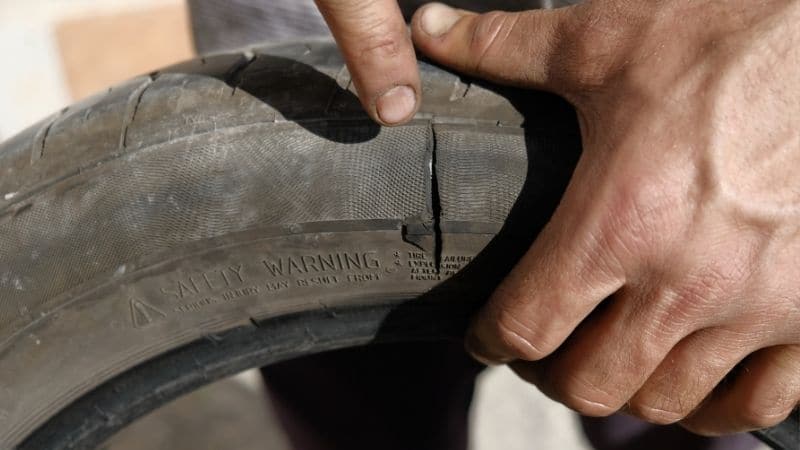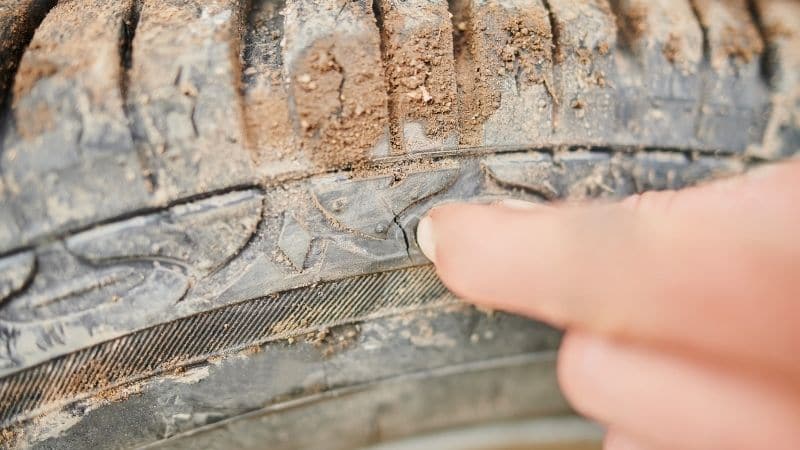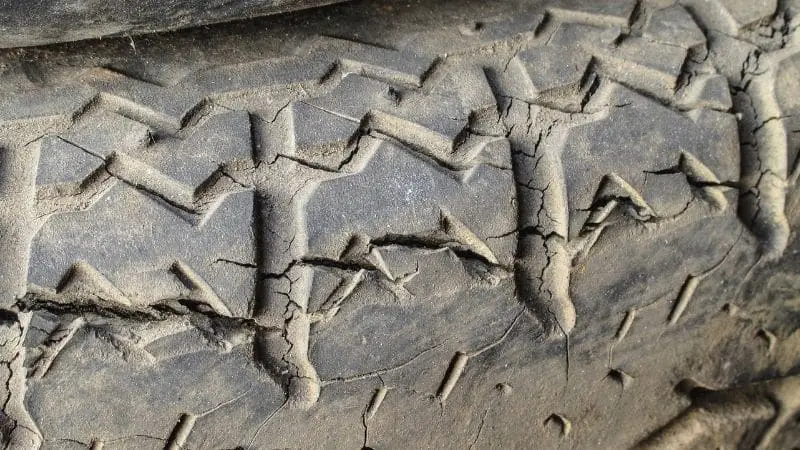The presence of small tears or cracks in a tire’s sidewall is often a sign of weathering or ozone cracking, and the tire should be replaced.
Driving on a cracked tire is extremely dangerous because the tire’s strength and rigidity are compromised, and the tire could blow out while you’re on the road. If you’ve ever had a blowout, you know how dangerous it can be to lose control of your vehicle.
Tires are essential to vehicle operation; after all, you can’t move without them. They must be robust to support the weight of the vehicle without losing shape or flexibility.
There are lots of interesting things to know about cracked tires such as signs and causes of this condition, safety concerns as well as how to fix tire cracks.
Keep reading to learn more about cracked tires.
How Tires Are Manufactured
Understanding the materials needed to build a tire and how they operate will help you figure out why they fail.
Plies – The fundamental skeletal structure of the tire is made up of plies. They’re made of polyester wrapped around fiber threads and placed between two layers of rubber. They provide you with options.
Steel belts – Steel belts are made out of tiny steel wires that are braided together to create thicker cords. These are then weaved together to produce robust belts. 2–3 of them go longitudinally around each tire after being sandwiched between rubber.
Beads – These are rubber-coated steel beads that seal the tire to the wheel rim.
Chaffer – The firm rubber cap that encases the beads and protects the plies from unwanted friction is known as a chaffer.
Sidewall – Made of extra-thick rubber and imprinted with all of the tire’s identifying characteristics.
Tread area – For a softer ride, thick rubber manufactured from polymers that link together tightly to form molecules is applied over a cushioning gum layer. These are the bonds that weaken with time, causing cracks in the tires. Hard tread lasts a long time yet provides less grip. Soft tread holds quite well, but it wears down quickly.
What Causes Cracked Tires?

Now that we know more about the architecture of tires, let’s dig into what causes cracks in this amazing build. Damaged, cracked tires are caused by a combination of factors:
Ultraviolet (UV) Rays
The sun’s UV rays are the most dangerous to tires. Extreme heat weakens polymer bonds by causing them to expand and shrink. Although it is hard to safeguard your car at all times, garaging it or parking in the shade as much as possible can help to prolong the life of your tires.
Age
Polymers deteriorate with time, causing the tires to harden and lose elasticity. When the suppleness of a tire diminishes, it becomes brittle and susceptible to breaking.
You could imagine that the tires of an underused car that has been left in a garage for a long time are safe, but this is not the case.
To keep the tires supple, they need heat and natural lubricant. It’s a good idea to go for a drive now and again.
Water
This is a curious one since thick rubber is supposed to be waterproof. It is, for the most part. However, driving in rainy circumstances for an extended period might enable water to enter the rubber, weakening the structure once again.
Tire Pressure
Under-inflated tires have a bigger surface area in contact with the road than over-inflated tires. This raises the temperature and, as a result, the friction.
Over-inflated tires put undue stress on the tire’s sidewalls, causing bulging and cracking.
Defective Manufacturing
This does happen on occasion with newer automobiles, albeit it is uncommon. Return to the dealership and request a professional examination if your car is still relatively new.
Degradation
Rubber is a natural product derived from trees. As a result, it will biodegrade over time, and the process is irreversible. Even though protecting chemicals and compounds are introduced during manufacture, they will wear away with time.
When Your Car Has Been Parked For an Extended Period
If you park your automobile in a garage and do not use it for a lengthy period, the engine may be damaged. Dry rot, on the other hand, has the potential to be more harmful.
As previously indicated, lubricants and antioxidants prevent tires from deteriorating. If these protective compounds are not applied, they may evaporate or leak into the ground.
This effectively removes the protective covering from your vehicle, making it more prone to cracking.
Extreme Temperature And Humidity
Excessive temperatures and high humidity are two factors that might cause your tires to degrade. This process is normally slow; but, when the temperature is exceptionally high, the process accelerates.
The rubber hardens as it cools while drying at a low temperature. As a consequence, dry rot can establish itself more rapidly. Sunlight damages the protective characteristics of rubber at high temperatures, leading tires to shatter faster than at lower temperatures.
Poor Quality Tires
Dry rot or cracks will almost probably come from the use of low-quality materials in the production of your tires. Tires are vulnerable to several external conditions, as well as static friction with the road.
Unless the rubber and other components are of excellent quality, the cracking process will be faster, resulting in your tires degrading at an alarmingly fast rate.
Signs of a Cracked Tire

Now that we are aware of the causes of cracked tires, it would be nice to know the signs to look out for.
Yes, it’s just mere cracks and they could be easy to spot (like in the image above). However, it’s still important to have a set of parameters that back your decision.
When your vehicle’s tires have cracks, you’ll notice the following signs:
1. Rubber That is Dry And Brittle
Oils and antioxidants preserve the rubber components of tires. These protecting chemicals may wear away with repeated use. When you feel your tires, they seem dry and brittle.
2. Cracks in Sidewalls
Have you ever observed splits and fractures in your tire’s sidewalls? They may occur on both sides and are the most obvious evidence that your tires have been broken.
3. Cracks in The Floor
Cracks might also form on the outside margins of your tire tread. This is frequently the result of extensive dry rot. Even if the tread depth is sufficient, the fissures might damage your car’s handling.
4. Color That Has Faded
Dry rot may be the cause of your automobile tire’s black hue becoming gray. Before the cracking occurs, the color may begin to fade. They can, however, both occur at the same time.
Safety Concerns Regarding Cracked Tires

Minor cracks may seem benign at first glance, but they are often a sign of more significant issues to come. If there are any cracks in the tire, it’s advisable to get it checked out by a professional and, if required, to have the tire replaced.
Although cracks in the treads are not as damaging as flaws in the sidewalls, having fissures in the sidewalls might cause catastrophic failure (the same reason tire stretching is dangerous). If the tires start to separate while you’re driving, you might lose control of the vehicle.
Deep cracks or improper inflation might cause under-inflated tires to deteriorate more quickly than correctly inflated tires.
How to Fix Your Cracked Tire
You have the option of replacing your tires if dry rot develops. However, if you don’t like the thought of changing your tires every year, it’s a good idea to learn how to mend them. The procedures for repairing your damaged tires are outlined below.
Method 1: Using a Sealant to Repair Internal Cracks
When the cracks are minor and not visible, sealants might be used to repair them. To ensure that this process is carried out correctly, you must get a sealant that is appropriate for your tires.
Here are the resources you’ll require:
- a suitable dry rot sealant
- Tire inflator
- Tire pressure gauge
- 1/2″ socket wrench or lug wrench
Step-by-Step Instructions
Here are the steps to seal tire cracks with a sealant:
1. Let your tires cool down
Your car warms up naturally while you drive it, as you may have seen. The contact between the tires and the ground causes the tires to heat up. Allow your automobile to cool down before applying a sealant to the cracks if you’ve recently driven it.
2. Tires must be removed
The next step is to jack up your car and remove the damaged tires. You can’t effectively repair tires if they aren’t mounted to your vehicle. As a result, you’ll need a lug wrench or a 1/2″ socket wrench to remove your tires and properly repair them.
3. Examine the Damage Level
The severity of the damage will determine whether your tires can be repaired or need to be replaced. This examination also helps you to view the affected region. You can come up with a good plan to fix the tires once you have a clear picture of the situation.
4. Put on the Sealant
Depending on the kind of sealant, you may need to follow the manufacturer’s directions. Some sealants, on the other hand, do not require any special preparation. They’re ready to use straight away. Insert the injector into the valve stem to apply the sealant to the insides of your tires.

5. Tires should be reinflated
Your tires may have lost some air as a result of the sealant application. As a result, you must re-inflate them. To ensure that the pressure is correct, use the pressure gauge.
6. Tires should be reinstalled
Replace your tires on your car once they’ve been repaired. Some sealants require you to drive your automobile right away after they’ve been installed. This allows the sealant to circulate and effectively cover the fractures.
Method 2: Applying a Protectant to External Cracks
This approach is good for obvious cracks. Cracks may be filled with a protectant, which also helps to protect the rubber from UV radiation.
The following are the tools you’ll need:
- a water hose
- a large sponge
- a water-based tire degreaser
- a tire protectant
Step-by-Step Instructions
The Steps to apply protectant are:
1. Allow your tires to cool before removing them and inspecting them
You must wait until your tires are cold before inspecting them, like with the previous procedure. The examination will reveal the location of the principal issue and if it is repairable.
2. Degrease using a degreaser
Apply the degreaser to your tires using the big sponge. Apply it to all parts of the tires, concentrating on the cracked areas. Scrub the tire vigorously to get the degreaser all over it.
3. Tires should be wiped and rinsed
Allow your tires to dry after using the degreaser. Wipe off with a clean towel once dry, then rinse with the water hose.
4. Tire Protectant should be used
Apply the tire protectant once the tires have dried after rinsing. Spray the protectant on the full surface of the tires according to the manufacturer’s instructions.

5. Replace your tires and inspect them once more
The cracks should be repaired once you’ve treated your tires. You can put your tires back on your automobile. If indications of dry rot persist, repeat the method for better results.
How to Prevent Tires From Cracking
Although your tires will never be completely new again, you can maintain their lifetime extended and prevent them from splitting prematurely by taking the following precautions:
- Don’t buy low-quality tires
- Clean them regularly
- Cover your car when it’s parked outside
- Maintain proper tire pressure
- Inspect your tires regularly
- and apply tire protectants frequently.
Conclusion
UV exposure and oxygen, as well as vehicle storage and driving conditions, are major contributors to tire degradation. Knowing what cracked tires are might assist you in maintaining the health of your tires.
The safety of the driver and the other passengers in the vehicle is of the utmost importance. This is simply accomplished by detecting when a tire has reached the end of its useful life and should be replaced. Averagely, tires should last for about six years!
Hi, my name is Niklas, the head content creator & CEO of Whirling Wheelz. I am very interested in vehicles of all kinds, mainly cars. I have a car mechanics degree from high school and a big hobby of mine is to follow the WRC (World Rally Championship) both online and through travel.


